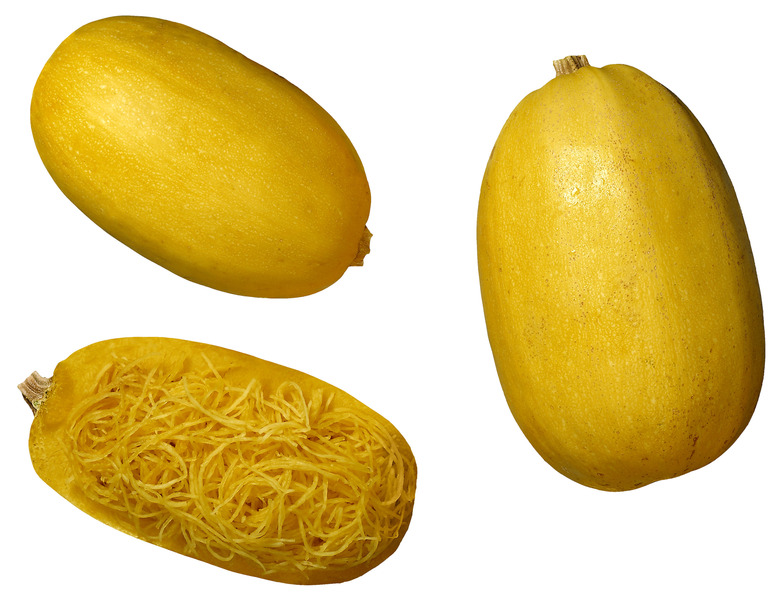What Does An Immature Spaghetti Squash Look Like?
Spaghetti squash (Cucurbita pepo) are the ultimate secret weapon for sneaking vitamins into an unsuspecting child's diet. Once the flesh has been scraped from the rind and cooked, spaghetti squash really does resemble the pasta for which it's named. Whether you prefer it drizzled with tomato sauce and Parmesan cheese as a gluten-free pasta alternative or steamed as a simple side dish, the vegetable itself is among the most interesting winter squash types to grow and cook. To ensure success in taking spaghetti squash from the garden to the table, you'll need to know how to distinguish an immature spaghetti squash from one that is ready to be harvested.
Timing Guidelines
Step 1
Whether you start your spaghetti squash plants indoors in the spring or direct seed them outside in late spring, it's important to keep track of the seeding date. Winter squash "days to maturity" mark the time between seeding and harvest. The cultivar "Hasta La Pasta" is one of the earlier spaghetti squash varieties and is ready about 85 days after seeding. "Vegetable Spaghetti," on the other hand, may still be immature until about 110 days after seeding.
- Spaghetti squash (Cucurbita pepo) are the ultimate secret weapon for sneaking vitamins into an unsuspecting child's diet.
- To ensure success in taking spaghetti squash from the garden to the table, you'll need to know how to distinguish an immature spaghetti squash from one that is ready to be harvested.
Rind Color
Step 1
While they are still at the immature stage, spaghetti squashes will be greenish and mottled rather than the yellow or orange color you will see at maturity. A mature spaghetti squash will be a solid color and will look similar to the photo and description on the seed packet or nursery tag. As their name indicates, the category of spaghetti squash grouped as orange types will turn a solid orange color upon maturity. Vegetable-type spaghetti squash tend to have yellow or gold rinds when they are ready to harvest.
Rind Texture
Step 1
Look at and feel the texture of the spaghetti squash's rind as it nears harvest time. An immature squash will feel tender on its exterior, while a mature squash will feel hard. As an experiment, press your fingernail into the rind of one squash and examine it to see if you can find the dent. An immature spaghetti squash dents easily, while a mature squash resists dents and blemishes from contact with other objects. Hard exteriors allow ripe spaghetti squash to keep well after you harvest them. If you're in the garden with your family, remind them that experimental prodding should be kept to a minimum — the vegetables bruise easily while immature.
- While they are still at the immature stage, spaghetti squashes will be greenish and mottled rather than the yellow or orange color you will see at maturity.
- As their name indicates, the category of spaghetti squash grouped as orange types will turn a solid orange color upon maturity.
Vine Characteristics
Step 1
While spaghetti squash are still at the immature stage, their stems and the vines on which they are growing will still be green and tender. Mature spaghetti squashes will have dry, hard stems. The vines themselves also turn dry and papery at harvest time. One exception to this rule of thumb is if the frost beats you to the squash patch. Once frost hits, the vines can die back, whether the squash are mature or not. Salvage frost-damaged spaghetti squash — even if they haven't fully ripened — by cutting them from the vine immediately. Cook the vegetables as soon as possible, because immature or frost-damaged spaghetti squash does not keep long.
- While spaghetti squash are still at the immature stage, their stems and the vines on which they are growing will still be green and tender.
- Once frost hits, the vines can die back, whether the squash are mature or not.
References
- Purdue University Extension: Production, Fruit Quality, and Nutritional Value of Spaghetti Squash
- Harvest to Table: How to Grow Winter Squash
- University of Illinois Extension: Winter Squash
- University of California Master Gardeners Santa Clara County: Winter Squash Trial
- Brigham Young University: Harvesting Tips and Information
